Wednesday, April 30, 2008
Eternal questions
Sunday, April 27, 2008
The glass block quest continues
This seems like an unlikely building to be included in a hunt for Mid-Century Modern design elements, doesn't it?
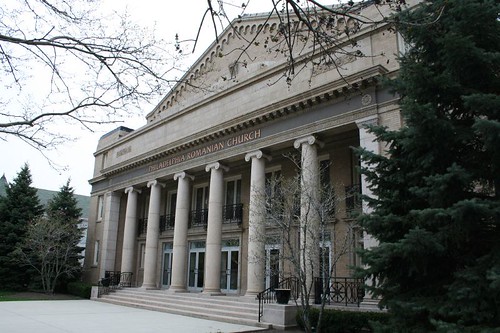
And yet, here it is, the Philadelphia Romanian Church. A series of massive windows into this Lakeview church's basement rec room were infilled with the same geometrically patterned glass block that's so common on suburban Chicago houses and apartments.
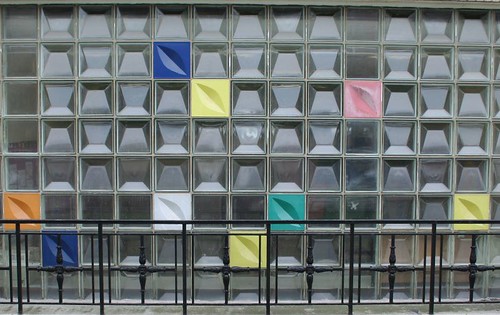

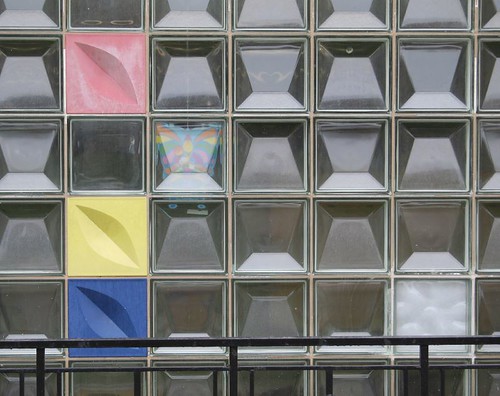
I found it by chance this afternoon, and was delighted. An identical design adorns both sides of the building. I snapped away.
And then it occurred to me, this is a church. Why not try to go in, and see what the back side of these things look like? So I did.
Now, I've been in a lot of churches -- 50 or more in St. Louis, at least a dozen in Milwaukee, and a handful in Chicago. Churches in general are amazingly open and welcoming to a guy who wanders in off the street, camera in hand, wanting to take snapshots of their sanctuary. Either they're in a landmark building and they're used to it, or else they're pleased and proud that someone thinks their home is worth photographing. Sometimes they even say "come on in" during their services, an invitation I always have to refuse, as I feel it's just too disruptive and disrespectful to run around during a service taking photographs. I just come back later, when the service is done.
In all my travels, I can think of only two times I've actually been denied access to a church. One was in north St. Louis, and they said they'd have to run it by their board first. The other... was today. At this place.
They wouldn't let me in to photograph their basement windows.
There didn't seem to be much of anything going on, but a short, stout man at the door simply told me "no". No reason, just "No, no, outside only. Not inside." Denied!
However, during our short conversation, I did glance over his shoulder, and saw the north window wall, including one of the colored blocks. It was glowing red in the light coming through the window.
They glow! They're translucent!!
Can you just imagine what something like THIS must look like from the inside?

...to say nothing of something like this!
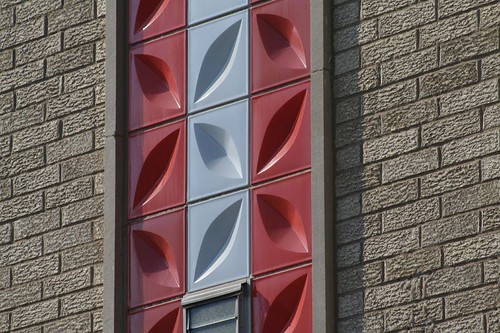
Now I have to get inside some of these buildings. This is now a holy mission.

And yet, here it is, the Philadelphia Romanian Church. A series of massive windows into this Lakeview church's basement rec room were infilled with the same geometrically patterned glass block that's so common on suburban Chicago houses and apartments.



I found it by chance this afternoon, and was delighted. An identical design adorns both sides of the building. I snapped away.
And then it occurred to me, this is a church. Why not try to go in, and see what the back side of these things look like? So I did.
Now, I've been in a lot of churches -- 50 or more in St. Louis, at least a dozen in Milwaukee, and a handful in Chicago. Churches in general are amazingly open and welcoming to a guy who wanders in off the street, camera in hand, wanting to take snapshots of their sanctuary. Either they're in a landmark building and they're used to it, or else they're pleased and proud that someone thinks their home is worth photographing. Sometimes they even say "come on in" during their services, an invitation I always have to refuse, as I feel it's just too disruptive and disrespectful to run around during a service taking photographs. I just come back later, when the service is done.
In all my travels, I can think of only two times I've actually been denied access to a church. One was in north St. Louis, and they said they'd have to run it by their board first. The other... was today. At this place.
They wouldn't let me in to photograph their basement windows.
There didn't seem to be much of anything going on, but a short, stout man at the door simply told me "no". No reason, just "No, no, outside only. Not inside." Denied!
However, during our short conversation, I did glance over his shoulder, and saw the north window wall, including one of the colored blocks. It was glowing red in the light coming through the window.
They glow! They're translucent!!
Can you just imagine what something like THIS must look like from the inside?

...to say nothing of something like this!

Now I have to get inside some of these buildings. This is now a holy mission.
Saturday, April 26, 2008
2 Buildings by Andrew Rebori
Madonna della Strada Chapel, Loyola University, 1939
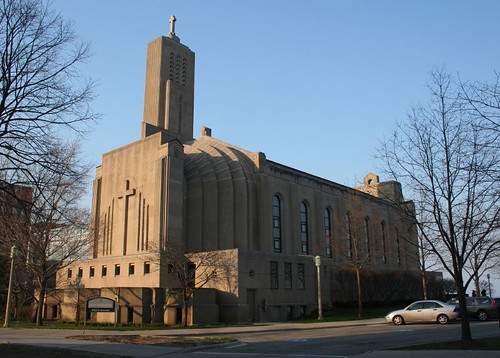
I have yet to get inside this place, but I will. Oh, I will.
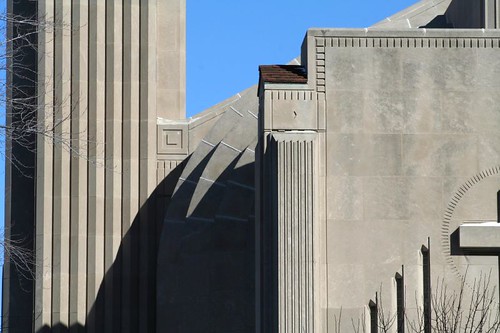
The outside is a sharply defined arrangement of bold, angular masses. The main entrance actually faces the lake; this is the back. Oh, if only all buildings could have a backside half this good!
Frank F. Fischer Apartments, 1209 N. State, 1937

I saw this one in a photograph somewhere, and knew I had to pay a visit. Behind that Streamline facade, there's a thin, lengthy apartment building on the right, facing a narrow courtyard on the left. It's possible to go nose-to-the-glass and see it from the outside, but it can't be photographed very well.

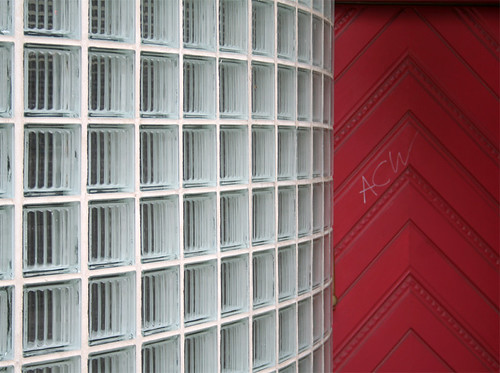
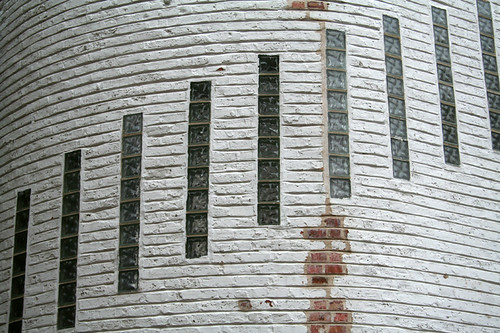
The vertical glass block strips illuminate a sheltered exterior stairwell.
I just discovered Mr. Rebori's name recently, so I'm sure to be tracking down more of his buildings.

I have yet to get inside this place, but I will. Oh, I will.

The outside is a sharply defined arrangement of bold, angular masses. The main entrance actually faces the lake; this is the back. Oh, if only all buildings could have a backside half this good!
Frank F. Fischer Apartments, 1209 N. State, 1937

I saw this one in a photograph somewhere, and knew I had to pay a visit. Behind that Streamline facade, there's a thin, lengthy apartment building on the right, facing a narrow courtyard on the left. It's possible to go nose-to-the-glass and see it from the outside, but it can't be photographed very well.



The vertical glass block strips illuminate a sheltered exterior stairwell.
I just discovered Mr. Rebori's name recently, so I'm sure to be tracking down more of his buildings.
Friday, April 25, 2008
Deco joy
Chicago is not particularly famous for its Art Deco heritage. Although there are a few fine Deco skyscrapers downtown, most notably the amazing Carbide & Carbon tower, most of the Art Deco architecture I've found has been scattered and hidden.
The work of architect Andrew Rebori is worth special note, and I'll get to it in the next post. For this one, I want to share some of the more "ordinary" Art Deco buildings I've stumbled across in my travels.

This is 10 N. Elm Street, a highrise at the north end of River North, designed by B. Leo Steif in 1928.
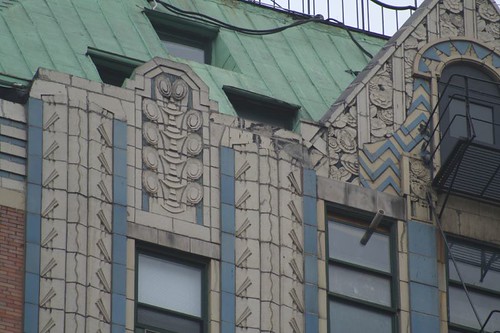
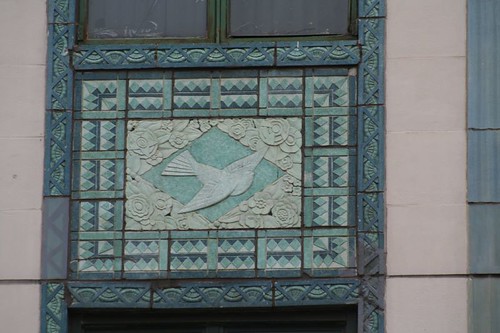
Cornice lines and transom panels are slathered with exuberant geometric designs, executed by Edouard Chassaing of the Northwestern Terra Cotta Company, freshly imported from France. And they would've continued all the way to the ground, too, except...
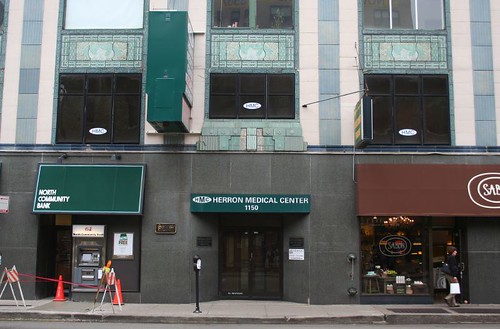
...the ground level was obliterated by one of the most unfortunate "modernizations" I've ever had the misfortune to lay eyes on. It burns my soul to think what they destroyed for this.
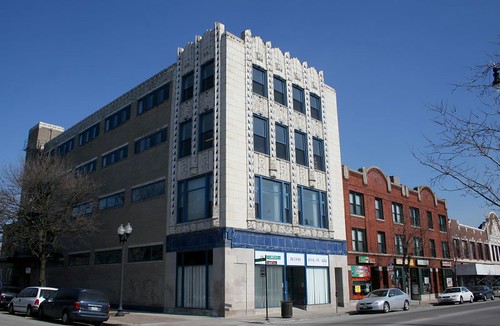
Next up, we have a jewel of a building out on western Lawrence Avenue, currently home to the Interstate Blood Bank. It was a neighbor of the recently-demolished Metro Theater building, and remains the crown jewel of the avenue's architecturally rich commercial buildings. Sadly, a quick web search reveals nothing about its past.
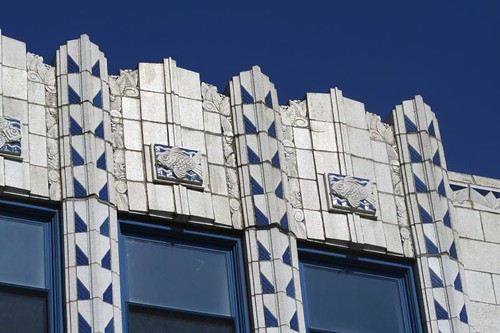
It's a stunning composition in creamy-white terracotta, with deep blue glazed highlights. Geometric plants, shapes, and fish are arranged on the spandrel panels and in ascending piers running the height of the building.
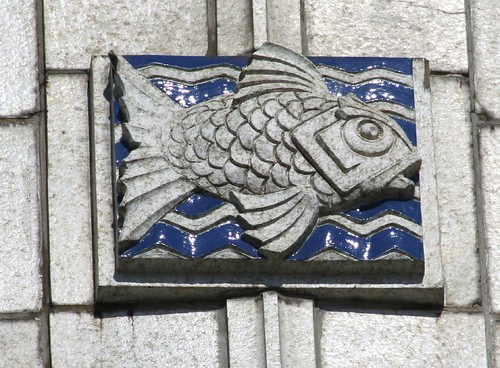
All that said... I don't know where these guys went fishing, but I ain't never seen a fish that looked like the ones on this building.
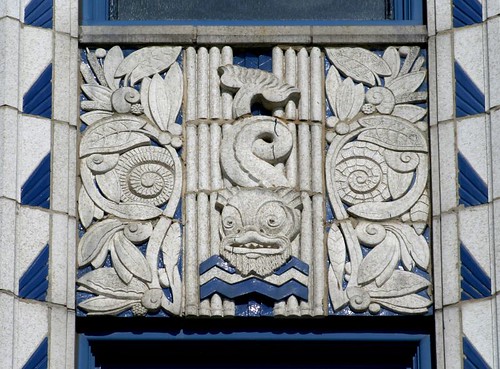
Our next stop is on a side street in eastern Rogers Park, 1521 W. Sherwin.

This six-story apartment building doesn't look like much from afar, but first impressions can be deceptive.
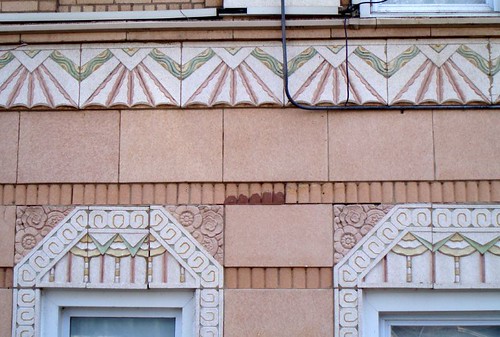
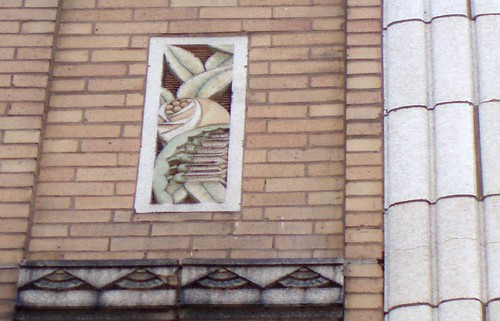
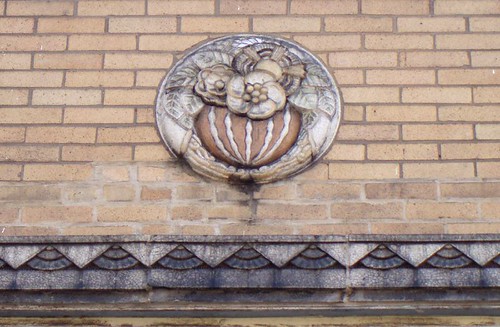
Next stop: Milwaukee Avenue at Montrose, where this sea-green building is squeezed to fit into the acute angle of two major streets' intersection.
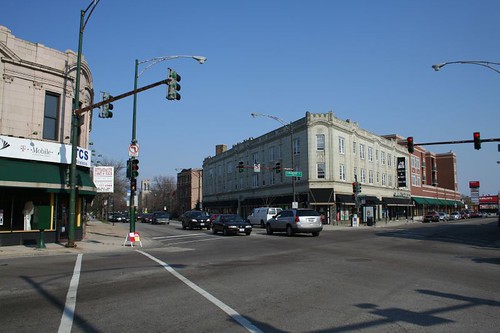
The overall effect of this building isn't quite as Jazz Age as it could be; there's something more historical about its general aura. But the details tell a different story.
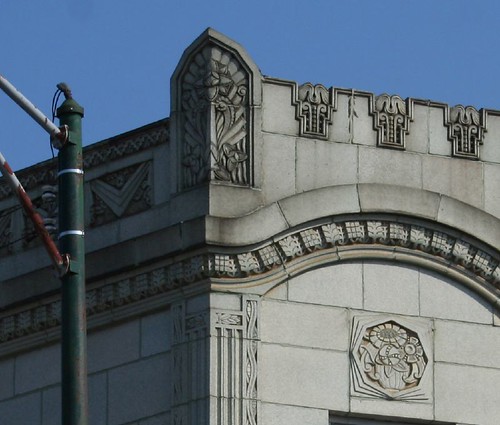
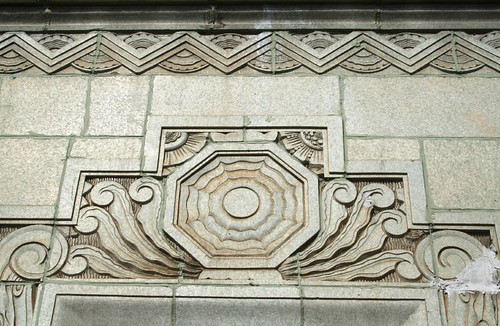
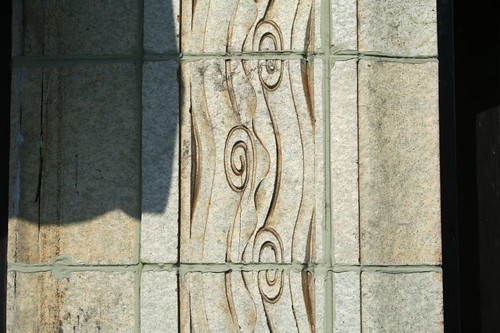
A stroll down Devon Avenue offers many rewards, architectural and otherwise. Among the wildly varied historical styles that adorn the avenue's many commercial buildings, a few Deco details may be found.
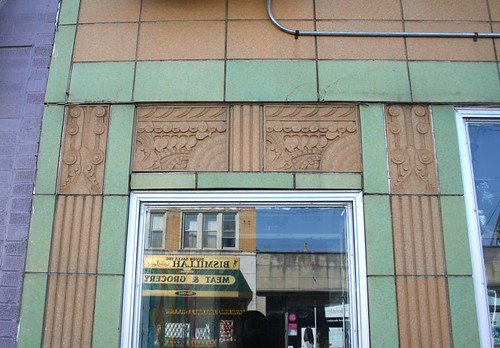

And that's all I got for now. The hunt continues!
The work of architect Andrew Rebori is worth special note, and I'll get to it in the next post. For this one, I want to share some of the more "ordinary" Art Deco buildings I've stumbled across in my travels.

This is 10 N. Elm Street, a highrise at the north end of River North, designed by B. Leo Steif in 1928.


Cornice lines and transom panels are slathered with exuberant geometric designs, executed by Edouard Chassaing of the Northwestern Terra Cotta Company, freshly imported from France. And they would've continued all the way to the ground, too, except...

...the ground level was obliterated by one of the most unfortunate "modernizations" I've ever had the misfortune to lay eyes on. It burns my soul to think what they destroyed for this.

Next up, we have a jewel of a building out on western Lawrence Avenue, currently home to the Interstate Blood Bank. It was a neighbor of the recently-demolished Metro Theater building, and remains the crown jewel of the avenue's architecturally rich commercial buildings. Sadly, a quick web search reveals nothing about its past.

It's a stunning composition in creamy-white terracotta, with deep blue glazed highlights. Geometric plants, shapes, and fish are arranged on the spandrel panels and in ascending piers running the height of the building.

All that said... I don't know where these guys went fishing, but I ain't never seen a fish that looked like the ones on this building.

Our next stop is on a side street in eastern Rogers Park, 1521 W. Sherwin.

This six-story apartment building doesn't look like much from afar, but first impressions can be deceptive.



Next stop: Milwaukee Avenue at Montrose, where this sea-green building is squeezed to fit into the acute angle of two major streets' intersection.

The overall effect of this building isn't quite as Jazz Age as it could be; there's something more historical about its general aura. But the details tell a different story.



A stroll down Devon Avenue offers many rewards, architectural and otherwise. Among the wildly varied historical styles that adorn the avenue's many commercial buildings, a few Deco details may be found.


And that's all I got for now. The hunt continues!
Thursday, April 24, 2008
Mid-Century Suburbs Part 4: Storm door funk
I promise I'll get off the MCM kick shortly. But for now...
Below is a sampling of the standard Chicago Mid-Century storm door. It's got a solid bottom quarter panel, and a three-part upper section, with two sidelights flanking a clear central panel. The sidelights typically sport an applied geometric pattern, or a translucent, textured, colored plastic panel. The frame is built with stainless steel, polished to a mirror shine. Sometime the main panel is a series of movable slatted windows, allowing the storm door to double as a screen door.


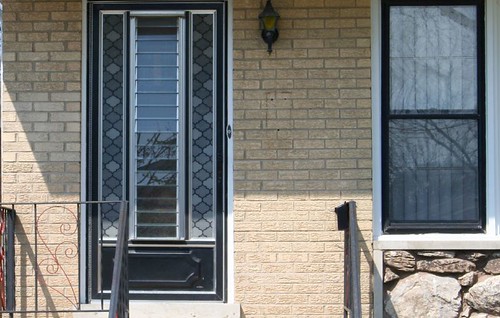


Much like the colored glass blocks, they appear all over Chicago, as if one builder or manufacturer had a chokehold on the entire industry. They're mostly on suburban-style ranch/bungalows, but I've even seen them on houses with medieval stylings, where they look strangely out of place.
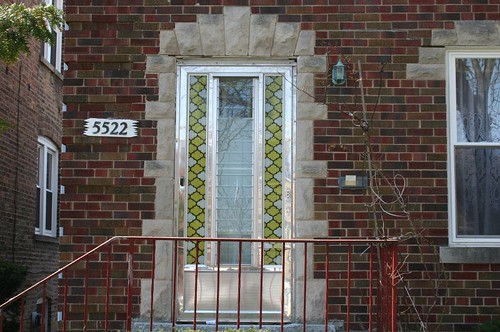
With the right elements, though, they're a key part of the Chicago mid-century look.

Below is a sampling of the standard Chicago Mid-Century storm door. It's got a solid bottom quarter panel, and a three-part upper section, with two sidelights flanking a clear central panel. The sidelights typically sport an applied geometric pattern, or a translucent, textured, colored plastic panel. The frame is built with stainless steel, polished to a mirror shine. Sometime the main panel is a series of movable slatted windows, allowing the storm door to double as a screen door.





Much like the colored glass blocks, they appear all over Chicago, as if one builder or manufacturer had a chokehold on the entire industry. They're mostly on suburban-style ranch/bungalows, but I've even seen them on houses with medieval stylings, where they look strangely out of place.

With the right elements, though, they're a key part of the Chicago mid-century look.

Wednesday, April 23, 2008
The joy of Chicago traffic reports
I just don't use the highway that often. Even in Milwaukee, I mostly got on the highway just to leave town. In Chicago, I've learned that, apart from Lake Shore Drive, highways are a traffic-snarled nightmare to be avoided at all costs.
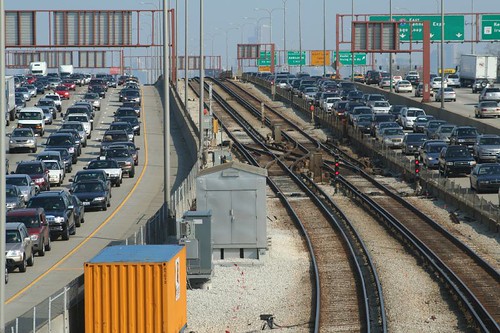
Still, sometimes I have to leave town, and wind up taking the Interstate. And doubtless like legions of new residents before me, I have found that the radio's traffic reports are utterly incomprehensible, even more so than in other cities.
I was certain that someone had addressed this problem, and indeed, Gaper's Block has a fairly good starting point, telling you what the hell stuff like "the Stevens inbound" and "the Circle" and "the Dan Ryan" are. Believe me, if you're not from here, it's utter nonsense. I can barely remember the Interstate numbers, let alone some arbitrary new names slapped on a ten mile stretch of highway as it passes through the city.
But even with guides and explanations, nobody seems to have put an actual map together. I'm a visual learner (duh), so it helps me much more to see a line labeled "Stevens Expressway" than to read a paragraph about it.
And what about travel times? Knowing that "you're 30 minutes to the Junction" doesn't help you at all if you don't know what the travel time is supposed to be. Is that fast? Ungodly slow? Who knows?? Again, a labeled map is what's needed.
And then, there's the use of random exits as reference points. I was once traveling southbound on I-55 (oh, sorry, I was outbound on the Stevens) and the traffic guys warned repeatedly of a deathly traffic tie-up at "Arsenal". Shit! Where's Arsenal? Is it coming up? Is it on my map? I drove on, expecting certain doom at any second.
Turns out "Arsenal" is waaaaaaaaay the hell out in the 'burbs, past the warehouse district, past Joliet even. It's pretty much the final marker of Chicago civilization. And by the time I got there, all signs of the traffic tie-up were gone.
So, uh, yeah. Thanks for nothin', Chicago radio.

Still, sometimes I have to leave town, and wind up taking the Interstate. And doubtless like legions of new residents before me, I have found that the radio's traffic reports are utterly incomprehensible, even more so than in other cities.
I was certain that someone had addressed this problem, and indeed, Gaper's Block has a fairly good starting point, telling you what the hell stuff like "the Stevens inbound" and "the Circle" and "the Dan Ryan" are. Believe me, if you're not from here, it's utter nonsense. I can barely remember the Interstate numbers, let alone some arbitrary new names slapped on a ten mile stretch of highway as it passes through the city.
But even with guides and explanations, nobody seems to have put an actual map together. I'm a visual learner (duh), so it helps me much more to see a line labeled "Stevens Expressway" than to read a paragraph about it.
And what about travel times? Knowing that "you're 30 minutes to the Junction" doesn't help you at all if you don't know what the travel time is supposed to be. Is that fast? Ungodly slow? Who knows?? Again, a labeled map is what's needed.
And then, there's the use of random exits as reference points. I was once traveling southbound on I-55 (oh, sorry, I was outbound on the Stevens) and the traffic guys warned repeatedly of a deathly traffic tie-up at "Arsenal". Shit! Where's Arsenal? Is it coming up? Is it on my map? I drove on, expecting certain doom at any second.
Turns out "Arsenal" is waaaaaaaaay the hell out in the 'burbs, past the warehouse district, past Joliet even. It's pretty much the final marker of Chicago civilization. And by the time I got there, all signs of the traffic tie-up were gone.
So, uh, yeah. Thanks for nothin', Chicago radio.
Tuesday, April 22, 2008
Something funky in Rogers Park
At first glance, it's nothing special, just another dull 1960s apartment block, sandwiched between other buildings older and newer, larger and smaller.
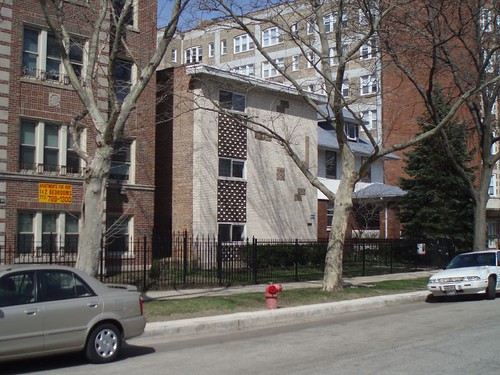
But... what's that stuff on it?
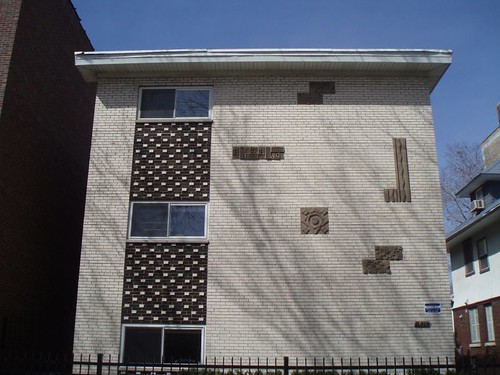
Glorious! A wall of cream brick, broken by a perfectly proportioned band of darker brown flecked with a grid of the cream brick, and with an assortment of inset abstract sculpture in concrete.
So... did somebody just have some sculpture laying around, or what?
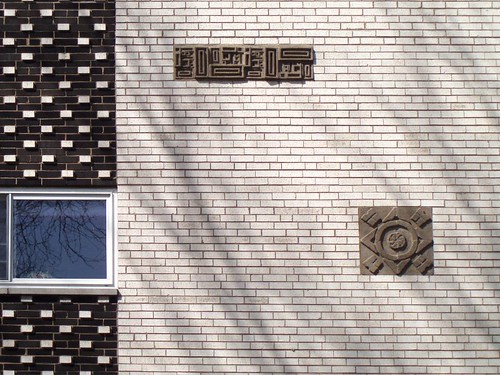
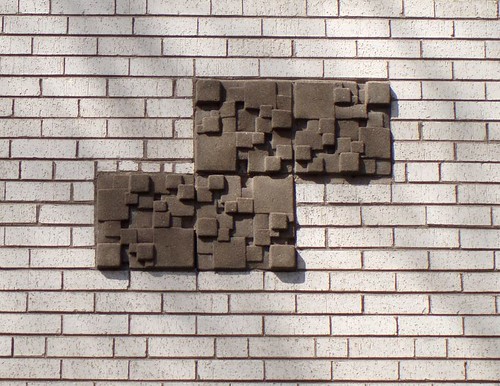
While these creative little bits of abstract sculpture are no doubt the highlight the building, there's also...
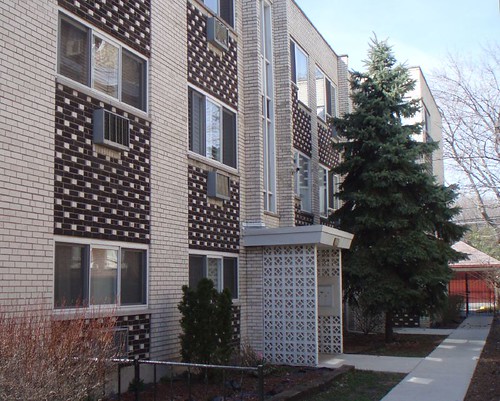
...one heck of an entryway, combining more of the checkerboard brick pattern from the front facade with concrete pattern blocks and a pair of demarcating brick piers. It's a tiny celebration!
It's at 1618 W. Sherwin Avenue, just off of Clark Street. It was built around 1962; the architect is N. S. Theodorou.

But... what's that stuff on it?

Glorious! A wall of cream brick, broken by a perfectly proportioned band of darker brown flecked with a grid of the cream brick, and with an assortment of inset abstract sculpture in concrete.
So... did somebody just have some sculpture laying around, or what?


While these creative little bits of abstract sculpture are no doubt the highlight the building, there's also...

...one heck of an entryway, combining more of the checkerboard brick pattern from the front facade with concrete pattern blocks and a pair of demarcating brick piers. It's a tiny celebration!
It's at 1618 W. Sherwin Avenue, just off of Clark Street. It was built around 1962; the architect is N. S. Theodorou.
Thursday, April 17, 2008
Triple blue brick attack!
I found the first one back in the fall, on W. Pratt at California.
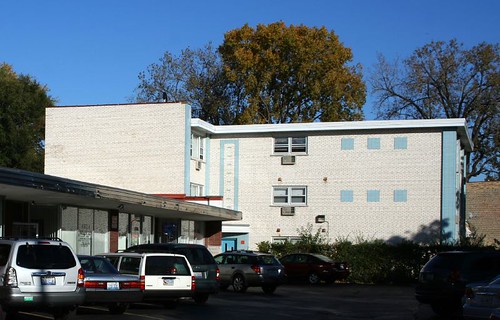
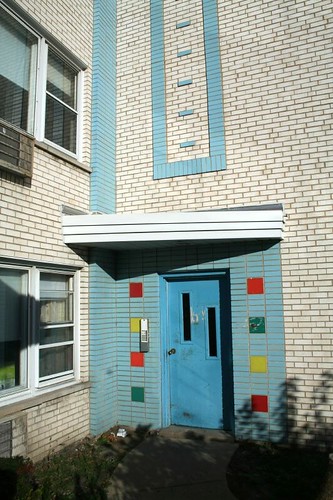
It's nothing special in plan or massing, just an ordinary Chicago apartment block, a bit lacking for windows. But it's clothed in the crazed spirit of the 1960s, when pastels were fine and spots of random color were king.
The entry is a confection of 1960s geometrical exuberance, with patterns in blue glazed brick laid against a cream brick background, and accents in colored tile. Blue piers highlight the building's corners and are used in a decorative grid of squares on an otherwise blank wall.
(Pratt, by the way, is a terrific shortcut for bicyclists looking to head west out of Rogers Park. There's enough stop signs that the traffic isn't roaring by too terribly fast, and it runs all the way out to the river without interruption.)
Then I bumped into another one while tooling around Rogers Park. Number 2 is at 1322 W. Chase Avenue, not far from the lake. It doesn't take much to see the connection. One's an oddity; two's a reproduction.
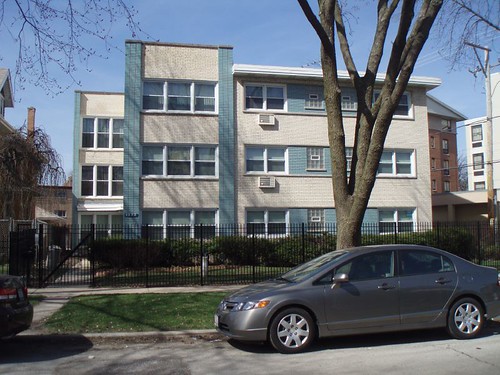

Sure enough, hidden behind shrubs and the neighbor's fence, there's that same entry detail. But wait! It's not quite the same -- the colors are different, and the tiles are separated by a soldier course of brick. Variations on a geometric theme -- sound familiar?
Then as the day wound down, I found a third one -- 7241 N. Claremont Avenue, just off of Touhy. If three buildings do it, then, folks, it's a organization!
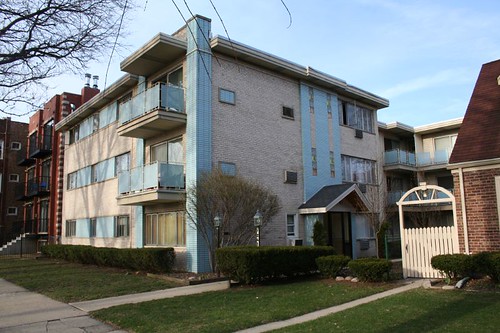
This one's the clear winner of the bunch. In addition to the blue brick piers, the limestone outlines, and the blue brick squares, it's got porch railing screens in the same spirit of exalted geometry. It's had an unfortunate gabled entry cover tacked on, which really should be a flat canopy, but otherwise it's still looking 60s snazzy.

But the real shocker came at the entrance, where, lo and behold...
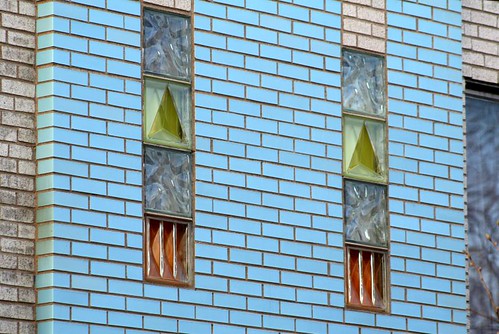
...there stood none other than the elusive geometric pattern blocks! Could this trio be yet another construct of my mystery suburban builder? The M.O. certainly fits. Stay tuned!
Edit: I've since found another half dozen of these buildings; photos may be seen here.


It's nothing special in plan or massing, just an ordinary Chicago apartment block, a bit lacking for windows. But it's clothed in the crazed spirit of the 1960s, when pastels were fine and spots of random color were king.
The entry is a confection of 1960s geometrical exuberance, with patterns in blue glazed brick laid against a cream brick background, and accents in colored tile. Blue piers highlight the building's corners and are used in a decorative grid of squares on an otherwise blank wall.
(Pratt, by the way, is a terrific shortcut for bicyclists looking to head west out of Rogers Park. There's enough stop signs that the traffic isn't roaring by too terribly fast, and it runs all the way out to the river without interruption.)
Then I bumped into another one while tooling around Rogers Park. Number 2 is at 1322 W. Chase Avenue, not far from the lake. It doesn't take much to see the connection. One's an oddity; two's a reproduction.


Sure enough, hidden behind shrubs and the neighbor's fence, there's that same entry detail. But wait! It's not quite the same -- the colors are different, and the tiles are separated by a soldier course of brick. Variations on a geometric theme -- sound familiar?
Then as the day wound down, I found a third one -- 7241 N. Claremont Avenue, just off of Touhy. If three buildings do it, then, folks, it's a organization!

This one's the clear winner of the bunch. In addition to the blue brick piers, the limestone outlines, and the blue brick squares, it's got porch railing screens in the same spirit of exalted geometry. It's had an unfortunate gabled entry cover tacked on, which really should be a flat canopy, but otherwise it's still looking 60s snazzy.

But the real shocker came at the entrance, where, lo and behold...

...there stood none other than the elusive geometric pattern blocks! Could this trio be yet another construct of my mystery suburban builder? The M.O. certainly fits. Stay tuned!
Edit: I've since found another half dozen of these buildings; photos may be seen here.
Subscribe to:
Posts (Atom)